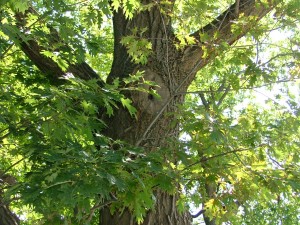
Oaks have greater habitat value than most other species.
All of the tree species listed below – even those which are non-native to Ontario – can be useful in urban plantings.
Naturalization and restoration projects should only use native species that were found in the local area historically. If you are concerned that climate change may change the species composition of our forests in the future, keep in mind that climate prediction science is still very young and the recommended approach at present is to use species that are found in the local region now, and source them from seed that came from individuals from the south end of the region so they are suited to the future warmer climate, if it changes. If the climate doesn’t change as drastically as predicted by some people, your project will still be successful. See the FGCA website for more info.
An ideal urban neighbourhood would have a mixture of these species at different ages to provide diversity in case of disease or storm damage. See Where to Plant for optimal growing conditions for these species and others. If your area has particular site conditions, such as dry sandy soils or hard clay, you should focus on the species that grow best in those conditions rather than plant some of everything.
Below is an interesting video about what to plant where for Ecosystem Functions of habitat. It explains how invasive species and native plants can tear down or build up an area.
| Species | Characteristics |
| Basswood | Fast growing, stump sprouts often |
| Black Cherry | Fast growing, not suited to alkaline sites |
| Black Oak | Tough, tolerates dry sites |
| Blue Spruce | Very salt tolerant |
| Bur Oak | Very urban tolerant |
| Crabapple | Fallen fruit can be messy |
| Green Ash | Overplanted, flower gall problem |
| Hackberry | May have witches broom if site is too dry. Not native to Toronto. |
| Hickories | Difficult to move but relatively urban tolerant |
| Honey Locust | Native variety has thorns (not Black locust); good barrier |
| Ironwood | Fast growing small tree, tolerant |
| Kentucky Coffee-tree | Very tolerant of urban areas |
| Norway Maple | Invasive; useful on some urban sites in downtown areas |
| Norway Spruce | Good salt tolerance |
| Pear | Edible fruit, often doesn’t need spraying |
| Pin Cherry | Fast growing, showy, often develops shoots at roots |
| Red Cedar | Very tolerant of salt & dryness |
| Red Maple | Very attractive in fall, needs acidic soil or leaves turn yellow. Often not a good choice for urban areas. |
| Red Oak | Fastest growing oak, tolerant of a little shade |
| Serviceberry | Small tree or large shrub, Several species choices. |
| Showy Mountain Ash | Small tree, showy |
| Silver Maple | Fast grower; do not plant near house foundations & pipes. |
| Sugar/Black Maple | Best in backyards where less root disturbance will occur |
| Sycamore | Fast growing, gets very large |
| Tamarack | Swamps, sun. Not good for dry sites. |
| Tulip Tree | Best where no root disturbance will occur, sandy loam soils only |
| Walnut | Moist sites on clay or loam soils |
| White Birch | Short lived, needs well-drained loam |
| White Cedar | Dry or wet tolerant, needs a lot of sun |
| White Oak | Tolerant, long lived, slow growing if not cared for |
| White Pine | Does well on gentle sites away from salt spray |
| White Spruce | Good salt tolerance, likes clay soils |
Douglas W. Tallamy author of “Bringing Nature Home: How You Can Sustain Wildlife with Native Plants”
